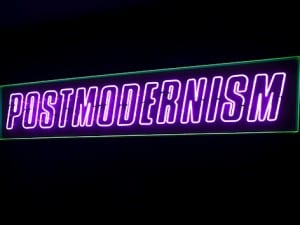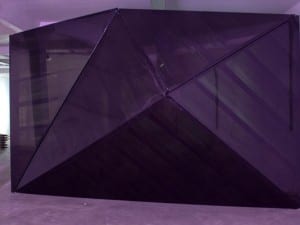There is something disarming about Tim Etchells’ immersive environments in which the ordinary and the mundane suddenly become laced with an unknown potency. Two walls of the Bermondsey Street gallery are covered in sheets of paper, some nicely framed, others just tacked to the wall. They bear messages which are at first unremarkable in their quotidian nature or simply appear to be ramblings of a lunatic. They say things like “The more you look at it the more it looks like a warning” and “Something that could have been not something that was”. They feel like warnings, incantations and predictions that neither have basis in reality nor an audience apart from their author.
The work, Personal Statement (2015), appears to be both a cluster of complete entities and yet perennially unfinished: it could go on forever, or it could just subsist as it is, a snapshot of some mysterious mind at work on a project of self-expression. As you study them, what began as an endearing eccentricity bleeds into a highly strung tension; the feeling that something ghastly is going to happen – or, still worse, has already happened unbeknown to you – descends and you realise that these innocent notices have a darker side. But the lightness of the paper, the array of coloured inks and the deliberate, almost tranquil handwriting mitigate any fear, leaving only a sense of bemused aesthetic wonderment.
In the Bermondsey Square gallery, which is essentially a long shop front window, Etchells has installed one of his celebrated neon pieces, Who Knows (2014). Jarring, sometimes garish neon signs that remind one of the old Soho say “I know”, “You know”, “We know”, “They Know”. Glowing in the dark of night especially they feel like a thousand demons threatening to expose our secrets. They tap in to the surveillance culture which we are so accustomed to that we no longer consider that our every step across town is monitored and recorded. Whatever we do, someone knows, and someone other than ourselves.
There is even a sinister undercurrent in the show’s title. The Facts on the Ground was used by the Bush/Blair administrations as a euphemism for the mess they had made in Iraq. The facts on the ground are a state of catastrophic chaos, but their public face is one of control and order. And therein lies the magic of Etchells’ work: the ordinary and the innocuous reveal and conceal a seething worry that simmers to a state of controlled panic over something that may or may not occur even though we do not know what it is; he makes things look both entirely self-explanatory and devilishly arbitrary. It’s almost as if Etchells sees that time and place – and all the facts on the ground – are radically unstable while the rest of us believe in some fictional continuity.
Tim Etchells: The Facts on the Ground, until 25 April, Vitrine Gallery, Bermondsey Street & Square, London.
Daniel Barnes
Credits
Tim Etchells, Who Knows, 2014.





